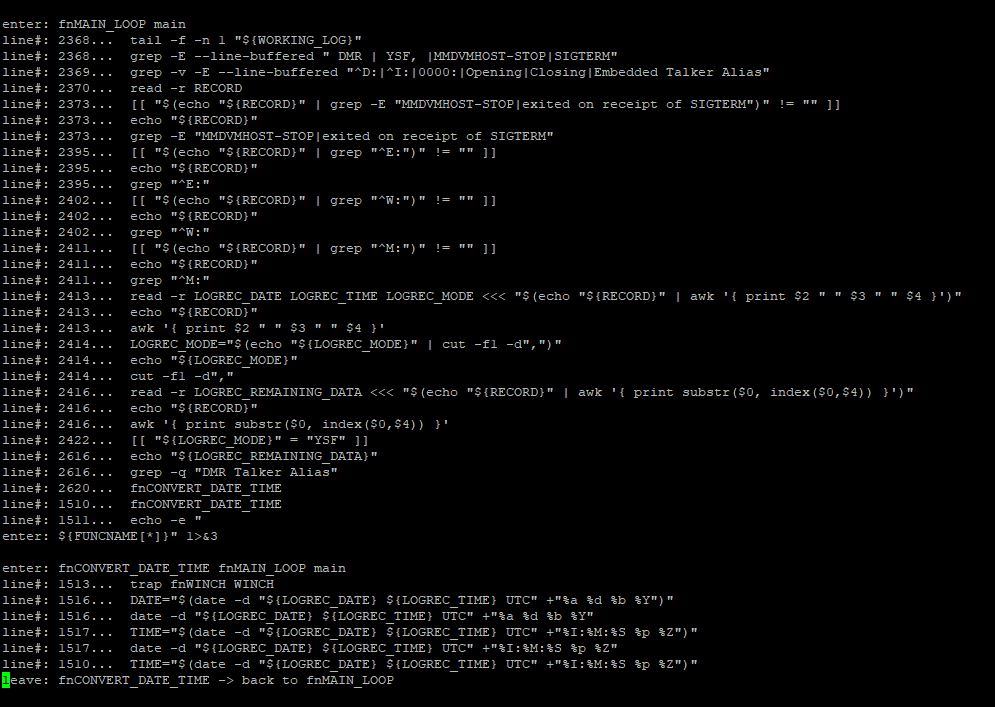This file will attempt to explain the method I chose to use, to implement a debugging log feature, in the pistar-lastqso script.
This feature is intended for use during testing & development.
USING THIS CAN HAVE A HUGE PERFORMANCE IMPACT ON A PI ZERO!
It's use by the user will yield no ill effects (other than the performance impact noted), and the output contained in the resulting debugging log may be of limited (if any) value to the user. But for those thinking of their own scripts, or who would modify pistar-lastqso for their own needs, the debug log feature demonstrated here could be of some help.
Creating a debug log is done by redirecting file descriptor 3 to a logfile of your choosing, when launching pistar-lastqso from the commandline. Basic output redirection should be nothing new to anyone who has spent a reasonable amount of time using any UNIX or Linux shell, so I won't go into detail regarding the basics of output redirection.
$ pistar-lastqso [any options and parameters] 3> /tmp/debug.log
Why "3"? Because linux normally has three built-in file descriptors already spoken for, by default. They are:
- File Descriptor 0: stdin (keyboard, "< filename", etc.)
- File Descriptor 1: stdout (standard output)
- File Descriptor 2: stderr (standard error)
This script adds, for the duration of it's execution, file descriptor 3, as an I/O channel we can send debugging data to. You can think of it as:
- File descriptor 3: debug
Normal screen output will be unaffected. But behind the scenes it is also writing debugging information. This always-generated information either goes to the bit-bucket (/dev/null) when NO redirection of fd3 is specified on the commandline, OR is sent TO the user-specified logfile. There is no cross contamination between screen and debug output.
Set up the inheritance needed to gather what we need, within functions.
Ensure that ERR traps are inherited by functions, command substitutions, and subshell environments.
set -o errtrace
Ensure that DEBUG and RETURN traps are inherited by functions, command substitutions, and subshell environments. (The -E causes errors within functions to bubble up.)
set -E -o functrace
If it doesn't already exist, create the file descriptor.
[ -e /proc/self/fd/3 ] || exec 3> /dev/null
Next, we define the traps that leverage the file descriptor. The "errtrace" and "functrace" options we enabled above, allow these traps to operate as intended within functions, as well.
The DEBUG trap...
This trap writes each line to be executed, just before it is executed, to the debug log.
trap 'echo -e "line#: ${LINENO}...\t${BASH_COMMAND}" >&3' DEBUG
The ERR trap...
This trap will log all non-0 return codes. To prevent some commands from tripping an ERR trap by returning a non-0 return code, I'm imediately following those commands with "|| :" ("or true"). An example would be a grep that doesn't find it's search string (return code 1). In other words, not all non-0 return codes are "errors" per se, but the trap will spot and report them. These can then be investigated to determine if an actual error has occurred.
trap 'echo -e "NON-0: LINE ${LINENO}: RETURN CODE: ${?}\t${BASH_COMMAND}" >&3' ERR
The RETURN trap...
This trap logs the completion of each function, upon return.
trap 'echo -e "leave: ${FUNCNAME} -> back to ${FUNCNAME[1]}\n" >&3' RETURN
Because the RETURN trap, above, logs only the return FROM a function, and not the entry INTO a function, I have added the following to every function of the script. It logs the full chain of nested functions that have taken me to that function.
echo -e "\nenter: ${FUNCNAME[*]}" >&3
Closing the file descriptor with the following, is performed in functions fnCHECK_MODES_ENABLED, fnABORT, and near the bottom of the script, just before the script re-launches itself.
exec 3>&- 2> /dev/null
A trap is used, to call a function named "fnABORT", in case the script terminates prematurely due to any of the signals listed. One of the commands it includes is to close the file descriptor. In the event the script fails to reach it's end normally, the fnABORT function will ensure the file descriptor gets closed.
trap fnABORT SIGHUP SIGINT SIGQUIT SIGABRT SIGTERM
The following detects whether file descriptor 3 has been redirected to a file. This is performed after the "exec" that sets up the file descriptor.
DEBUG_LOG="$(readlink /proc/self/fd/3 2>/dev/null)"
If no redirection has been applied by the user, "${DEBUG_LOG}" will be "/dev/null". But if the user has redirected fd 3 to a file, then "${DEBUG_LOG}" will contain the name (with full path), to the file.
if [ "${DEBUG_LOG}" != "/dev/null" ]
then
...
fi
When working on the pistar-lastqso script, I generally call upon the debugging feature, to ensure that I have all the diagnostics I need, to troubleshoot any problems.
$ pistar-lastqso [any options and parameters] 3> /tmp/debug.log
This document may be a little rough at the moment, but it includes all of the information needed to explain how the debug log feature was implemented. The bash documentation will give more information on every aspect of what's being used here.
